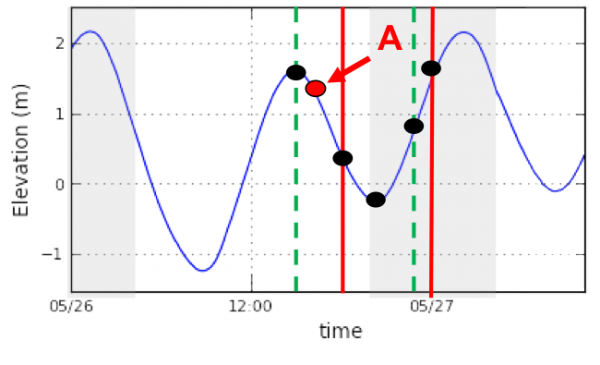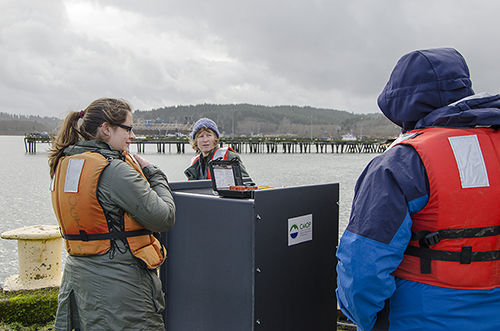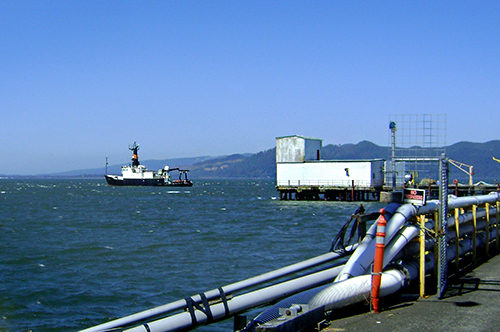You are here
CMOP Advances Sampling Strategies of Microbial Communities in Coastal Ecosystems
07/31/13 Astoria, Ore.
Scientists at CMOP recently collected the first autonomous adaptive samples from microbial communities in the Columbia River estuary. This scientific achievement was accomplished by integrating an Environmental Sample Processor (ESP) with the SATURN Observation Network station near Cathlamet Bay.
 The black dots in the figure represent the pre-programmed times when the ESP collected samples. The red dot marked A indicates when autonomous adaptive sampling occurred. The first adaptive sample was triggered by specific turbidity criteria.“The adaptive sample is a big step forward for us,” said Lydie Herfort, senior research associate at CMOP. “The ESP and SATURN-04 station successfully communicated with each other and followed a pre-programmed computer script written by Charles Seaton to capture a microbial sample when specific criteria were met.”
The black dots in the figure represent the pre-programmed times when the ESP collected samples. The red dot marked A indicates when autonomous adaptive sampling occurred. The first adaptive sample was triggered by specific turbidity criteria.“The adaptive sample is a big step forward for us,” said Lydie Herfort, senior research associate at CMOP. “The ESP and SATURN-04 station successfully communicated with each other and followed a pre-programmed computer script written by Charles Seaton to capture a microbial sample when specific criteria were met.”
The ESP is a robotic device that autonomously collects and analyzes subsurface water samples. ESPs are traditionally moored in the clear waters of the ocean and collect data from sensors attached to the instrument. CMOP is using it in a unique way by deploying it in the turbid waters of an estuary, from a pier, and performing adaptive sampling targeted to the timing and characteristics of specific biological hotspots.
 ESP in Simon lab at OHSU.During experiments in May, the ESP was set up to receive instructions from the SATURN-04 observation station near Cathlamet Bay. The station's computer read data sent from various sensors and a pump controller. Then at designated times or when sensors met specific adaptive sampling criteria, the computer sent instructions to the ESP to collect a sample.
ESP in Simon lab at OHSU.During experiments in May, the ESP was set up to receive instructions from the SATURN-04 observation station near Cathlamet Bay. The station's computer read data sent from various sensors and a pump controller. Then at designated times or when sensors met specific adaptive sampling criteria, the computer sent instructions to the ESP to collect a sample.
“The samples we collected over the varying tidal cycles (ebb, flood, spring) will provide us with critical information about the timing and magnitude of microbial transport (of particles) from the bay,” Herfort said.
The innovative research led by Holly Simon, a CMOP scientist and Oregon Health & Science University (OHSU) professor, uses the ESP to collect microorganisms in the estuary for DNA analysis the lab. Her multi-disciplinary team is significantly advancing the ESP’s ability to sample these communities that in turn will provide a better understanding of how biological hotspots interact with the river and ocean.
 Holly Simon (center) and her research team confer about the ESP – encased in protective container – at SATURN-04. “We have incorporated the ESP into the SATURN observation network, giving us the capability for autonomous biological sample collections at high resolution,” Simon said. “This high-resolution sampling will inform our understanding of how physical, biogeochemical, and microbial properties are linked, and how these linkages promote productivity of microbial hotspots in the Columbia River estuary. “
Holly Simon (center) and her research team confer about the ESP – encased in protective container – at SATURN-04. “We have incorporated the ESP into the SATURN observation network, giving us the capability for autonomous biological sample collections at high resolution,” Simon said. “This high-resolution sampling will inform our understanding of how physical, biogeochemical, and microbial properties are linked, and how these linkages promote productivity of microbial hotspots in the Columbia River estuary. “
This is a collaborative research project with scientists from CMOP, OHSU, Monterey Bay Aquarium Research Institute (MBARI) and Spyglass Biosecurities.
"Spyglass views the deployment of the ESP technology in the Columbia River estuary as another exciting step towards enabling a global network of portable water laboratories." said Chris Melançon, CEO of Spyglass Technologies, "As a CMOP Industry Partner, Spyglass is committed to continuing our work with the scientists and engineers at OHSU to deliver real-time biological information for enhancing our understanding of coastal ecosystems."
 Sampling the ETM with a tool kit that combines the R/V Oceanus, ESP, and SATURN-03 observation station.CMOP recently used the ESP as an integral part of a research field campaign studying the Estuary Turbidity Maxima (ETM). The ESP was stationed at SATURN-03, near Hammond Bay, while the Research Vessel Oceanus was in the south channel of the Columbia River. Both simultaneously collected water samples with comparable physical and biogeochemical properties through the ETM cycle. The ESP collected autonomous adaptive samples at the SATURN-03 station to compare with similar samples taken from a localized area of the south channel.
Sampling the ETM with a tool kit that combines the R/V Oceanus, ESP, and SATURN-03 observation station.CMOP recently used the ESP as an integral part of a research field campaign studying the Estuary Turbidity Maxima (ETM). The ESP was stationed at SATURN-03, near Hammond Bay, while the Research Vessel Oceanus was in the south channel of the Columbia River. Both simultaneously collected water samples with comparable physical and biogeochemical properties through the ETM cycle. The ESP collected autonomous adaptive samples at the SATURN-03 station to compare with similar samples taken from a localized area of the south channel.
Future studies with the ESP include identifying the formation of plankton blooms, specifically Mesodinium rubrum, and assessment of the impact on the estuarine microbial community of mixing ocean water containing low dissolved oxygen.
Chris Scholin, President and CEO of MBARI, and his research group, responsible for designing the instrument and its assays, see a unique opportunity with CMOP’s existing modeling, sampling, and sample processing capabilities to utilize the instrument in novel ways for observing microbial processes as they occur in nature.
“CMOP is in the unique position to use modeling of the Columbia River Estuary to address microbial processes that govern the flux of nutrients and energy by predicting where and when samples should be taken to address specific questions,” Scholin said. “What is most intriguing is to match that predictive capability with novel sampling and sample processing systems like the ESP so researchers can be more effective in establishing and testing hypotheses without the strict requirement of being in the field to carry out the collections.”
By pushing the capabilities of the ESP, CMOP is among the leading research centers around the world that are revolutionizing the way aquatic science is conducted to study microbial communities.
Written by Jeff Schilling






